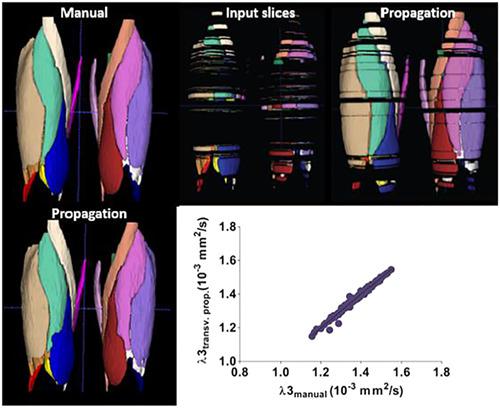当前位置:
X-MOL 学术
›
NMR Biomed.
›
论文详情
Our official English website, www.x-mol.net, welcomes your
feedback! (Note: you will need to create a separate account there.)
Supervised segmentation framework for evaluation of diffusion tensor imaging indices in skeletal muscle
NMR in Biomedicine ( IF 2.7 ) Pub Date : 2020-10-01 , DOI: 10.1002/nbm.4406 Laura Secondulfo 1 , Augustin C Ogier 2, 3 , Jithsa R Monte 4 , Vincent L Aengevaeren 5 , David Bendahan 3 , Aart J Nederveen 4 , Gustav J Strijkers 1 , Melissa T Hooijmans 1
NMR in Biomedicine ( IF 2.7 ) Pub Date : 2020-10-01 , DOI: 10.1002/nbm.4406 Laura Secondulfo 1 , Augustin C Ogier 2, 3 , Jithsa R Monte 4 , Vincent L Aengevaeren 5 , David Bendahan 3 , Aart J Nederveen 4 , Gustav J Strijkers 1 , Melissa T Hooijmans 1
Affiliation

|
Diffusion tensor imaging (DTI) is becoming a relevant diagnostic tool to understand muscle disease and map muscle recovery processes following physical activity or after injury. Segmenting all the individual leg muscles, necessary for quantification, is still a time‐consuming manual process. The purpose of this study was to evaluate the impact of a supervised semi‐automatic segmentation pipeline on the quantification of DTI indices in individual upper leg muscles. Longitudinally acquired MRI datasets (baseline, post‐marathon and follow‐up) of the upper legs of 11 subjects were used in this study. MR datasets consisted of a DTI and Dixon acquisition. Semi‐automatic segmentations for the upper leg muscles were performed using a transversal propagation approach developed by Ogier et al on the out‐of‐phase Dixon images at baseline. These segmentations were longitudinally propagated for the post‐marathon and follow‐up time points. Manual segmentations were performed on the water image of the Dixon for each of the time points. Dice similarity coefficients (DSCs) were calculated to compare the manual and semi‐automatic segmentations. Bland‐Altman and regression analyses were performed, to evaluate the impact of the two segmentation methods on mean diffusivity (MD), fractional anisotropy (FA) and the third eigenvalue (λ3). The average DSC for all analyzed muscles over all time points was 0.92 ± 0.01, ranging between 0.48 and 0.99. Bland‐Altman analysis showed that the 95% limits of agreement for MD, FA and λ3 ranged between 0.5% and 3.0% for the transversal propagation and between 0.7% and 3.0% for the longitudinal propagations. Similarly, regression analysis showed good correlation for MD, FA and λ3 (r = 0.99, p < 60; 0.0001). In conclusion, the supervised semi‐automatic segmentation framework successfully quantified DTI indices in the upper‐leg muscles compared with manual segmentation while only requiring manual input of 30% of the slices, resulting in a threefold reduction in segmentation time.
中文翻译:

用于评估骨骼肌弥散张量成像指数的监督分割框架
扩散张量成像 (DTI) 正在成为一种相关的诊断工具,可用于了解肌肉疾病并绘制身体活动后或受伤后的肌肉恢复过程。对量化所必需的所有腿部肌肉进行分割仍然是一个耗时的手动过程。本研究的目的是评估有监督的半自动分割管道对个体大腿肌肉 DTI 指数量化的影响。本研究使用了 11 名受试者的大腿纵向获得的 MRI 数据集(基线、马拉松后和随访)。MR 数据集由 DTI 和 Dixon 采集组成。使用 Ogier 等人在基线异相 Dixon 图像上开发的横向传播方法对大腿肌肉进行半自动分割。这些分段在马拉松后和后续时间点纵向传播。对每个时间点的 Dixon 的水图像进行手动分割。计算骰子相似系数(DSC)以比较手动和半自动分割。进行了 Bland-Altman 和回归分析,以评估两种分割方法对平均扩散率 (MD)、分数各向异性 (FA) 和第三特征值的影响。λ 3 )。所有时间点所有分析肌肉的平均 DSC 为 0.92 ± 0.01,范围在 0.48 和 0.99 之间。Bland-Altman 分析表明,MD、FA 和λ 3的 95% 一致性限制范围在横向传播的 0.5% 和 3.0% 之间,纵向传播的介于 0.7% 和 3.0% 之间。同样,回归分析显示 MD、FA 和λ 3具有良好的相关性(r = 0.99,p< 60; 0.0001)。总之,与手动分割相比,监督式半自动分割框架成功量化了大腿肌肉中的 DTI 指数,同时只需要手动输入 30% 的切片,从而将分割时间缩短了三倍。
更新日期:2020-12-08
中文翻译:

用于评估骨骼肌弥散张量成像指数的监督分割框架
扩散张量成像 (DTI) 正在成为一种相关的诊断工具,可用于了解肌肉疾病并绘制身体活动后或受伤后的肌肉恢复过程。对量化所必需的所有腿部肌肉进行分割仍然是一个耗时的手动过程。本研究的目的是评估有监督的半自动分割管道对个体大腿肌肉 DTI 指数量化的影响。本研究使用了 11 名受试者的大腿纵向获得的 MRI 数据集(基线、马拉松后和随访)。MR 数据集由 DTI 和 Dixon 采集组成。使用 Ogier 等人在基线异相 Dixon 图像上开发的横向传播方法对大腿肌肉进行半自动分割。这些分段在马拉松后和后续时间点纵向传播。对每个时间点的 Dixon 的水图像进行手动分割。计算骰子相似系数(DSC)以比较手动和半自动分割。进行了 Bland-Altman 和回归分析,以评估两种分割方法对平均扩散率 (MD)、分数各向异性 (FA) 和第三特征值的影响。λ 3 )。所有时间点所有分析肌肉的平均 DSC 为 0.92 ± 0.01,范围在 0.48 和 0.99 之间。Bland-Altman 分析表明,MD、FA 和λ 3的 95% 一致性限制范围在横向传播的 0.5% 和 3.0% 之间,纵向传播的介于 0.7% 和 3.0% 之间。同样,回归分析显示 MD、FA 和λ 3具有良好的相关性(r = 0.99,p< 60; 0.0001)。总之,与手动分割相比,监督式半自动分割框架成功量化了大腿肌肉中的 DTI 指数,同时只需要手动输入 30% 的切片,从而将分割时间缩短了三倍。











































 京公网安备 11010802027423号
京公网安备 11010802027423号